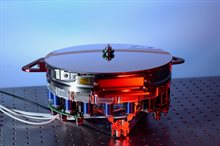HVR Deformable Mirrors
In the majority of cases, deformable mirrors used for advanced optics in telescopes, satellite communication and other applications are custom-made for each project, and are decades-old technologies with serious drawbacks. TNO has developed a superior, patented technology for deformable mirror actuators. It now stands ready to reduce non-recurring engineering and production costs by scaling its deformable mirror solution for a variety of applications.

Deformable mirrors are the key optical elements in adaptive optics systems, which allow for correction (or pre-correction) of optical wavefronts to offset atmospheric optical turbulence. This is relevant for any application in which an image or beam of light must still be precise after passing through air or other gasses.
Dedication to the industry
For decades, TNO has been contributing its expertise in active and adaptive optics to major, global satellite missions and telescope observatories. That expertise and TNO’s drive for innovation led to the development of a Hybrid Variable Reluctance (HVR) actuator, designed specifically for adaptive optics. It is orders of magnitude more power-efficient, compact, serviceable, robust and reliable than traditional voice coil or piezo actuated deformable mirrors. It is also highly linear with minimal hysteresis.
With the installation and proven operation of TNO’s HVR actuated adaptive secondary mirror (ASM) for the NASA Infrared Telescope Facility (NASA-IRTF), TNO’s technology has achieved the highest level of technological readiness for bespoke usage. The IRTF-ASM is 24 cm in diameter and has 36 actuators. TNO is currently building an adaptive secondary mirror with 62 cm diameter and 210 actuators for University of Hawaii’s 88-inch Telescope, and has started the design process for an adaptive secondary mirror for the Keck Telescope, which will be 1.4 meters in diameter and contain about 4000 actuators.
Through the Tech Transfer programme, TNO aims to make the HVR actuated deformable mirror as prolific in industry and science as possible, to enable broad and optimised benefit from its unique design and superior performance. A market study is underway to evaluate potential uses of the technology, not only for telescope and satellite communication applications, but also potentially for defence, fusion power and semiconductor manufacturing applications.

Cutting-edge new actuator technology
TNO’s new HVR actuator technology improves almost every aspect of deformable mirrors and their actuators up to an order of magnitude, as compared to voice coil or piezo alternatives. They enable further developments in mobile, compact, lightweight and high optical powered applications. Some of the benefits include:
- Highly linear actuators (~99%) with low hysteresis (~1-2%): enabling simpler open-loop controls and minimal internal sensors.
- High force output: actuators can bend mirrors over 3mm thick, making the deformable mirrors less fragile, more sealable and recoatable.
- High reliability: actuators are designed to never fail, with no wear or aging, redundant windings, originally designed for future space applications.
- Low-power electronics: only a few milliwatts per actuator for reduced heat dissipation and enabling passive or simple gas cooling.
- Highly compact: able to retrofit deformable mirrors in the volume of traditional static telescope mirrors and mounts, and scalable to large apertures and actuator pitches, as well as compact space applications.
- Replaceable/Serviceable: Although actuator failure is unlikely, they can be easily replaced if one occurs.
The TNO Ofelia laser communication demonstrator, included an HVR actuated deformable mirror, which helped achieve a 20-decibel gain of “photons on target” during a 10km ground test, indicating that the solution is not only compact and elegant, but also able to perform outgoing laser “pre-correction”, optimised to get the beam through a turbulent atmosphere. This makes it an ideally suited technology to not only enable the applications of tomorrow, but also to extend the lifetime, power, and accuracy of existing telescopes, satellite communication systems, and other applications such as high-powered lasers for defence and semiconductor manufacturing.
Are you a stakeholder in advanced optics, or an investor eager to make a major impact on the adaptive optics value chain? Want to discover how HVR Deformable Mirrors can revolutionise current and future applications?
